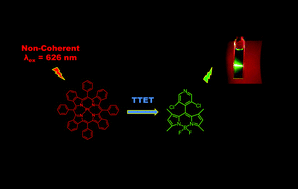Photochemical upconversion and triplet annihilation limit from a boron dipyrromethene emitter†
Abstract
Non-coherent sensitized red-to-green upconversion has been achieved utilizing platinum(II) tetraphenyltetrabenzoporphyrin (PtTPTBP) as the triplet sensitizer and a nearly quantitatively fluorescent meso-(2,6-dichloropyridyl)-substituted boron dipyrromethene (Cl2PyBODIPY) chromophore (Φ = 0.99 in toluene) as the energy acceptor/annihilator in deoxygenated toluene. Dynamic Stern–Volmer analysis revealed that PtTPTBP phosphorescence as quenched by Cl2PyBODIPY occurs with a KSV of 108 000 M−1, yielding a triplet–triplet energy transfer rate constant of 2.3 × 109 M−1 s−1. Using a non-coherent red light-emitting diode excitation source centered at 626 nm, the incident power dependence responsible for generating singlet BODIPY fluorescence in the green was shown to traverse quadratic to linear regimes, the latter being achieved near 60 mW cm−2. These data were consistent with a photochemical upconversion mechanism being responsible for generating singlet fluorescence from the Cl2PyBODIPY chromophores through sensitized triplet–triplet annihilation (TTA). Integrated delayed fluorescence transients were utilized to reveal the TTA efficiency for the Cl2PyBODIPY chromophore and saturated near 46%, representing the lower limit for the TTA process. Kinetic modelling of the delayed fluorescence transient produced from 1.5 mJ laser pulses (λex = 615 nm) revealed a maximum limiting TTA efficiency of 64% for this upconverting composition, implying that this is indeed an extremely relevant acceptor/annihilator composition for photochemical upconversion.


 Please wait while we load your content...
Please wait while we load your content...